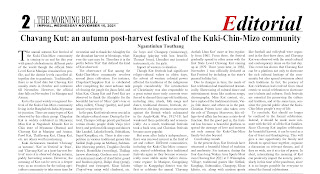Chavang Kut: an autumn post-harvest festival of the Kuki-Chin-Mizo community
Ngamtinlun Touthang
The annual autumn Kut festival of the Kuki-Chin-Mizo community is coming to an end for this year with grand celebrations in different parts of the world though the official State Level Kut in Manipur remained low profile, and the district levels cancelled altogether due to pandemic. Traditionally, there is no fixed date but Chavang Kut usually starts in October and continues till November. However, the official date falls on November 1 in Manipur and Assam.
Kut
is the most widely recognised festival of the Kuki-Chin-Mizo community living
in the Bangladesh-India-Myanmar tri-junction. There are many types of Kut observed
by this ethnic group. Chapchar Kut is
widely celebrated in Mizoram; Mim Kut
in Nagaland: Khuado Kut in Chin state
of Myanmar (Burma) and Chavang Kut in Manipur and Assam. Pawl Kut, Thalfavang Kut, Chang
Kut, etc. are others worth mentioning.
Kuki
dictionaries translate 'Chavang' as
'autumn', ‘Kut’ as 'festival' or
‘feast’, and ‘Chavang Kut’ as a
'post-harvest festival' since it is observed during autumn, paddy harvesting season.
However, the meaning of Kut can be
seen in a deeper way: as an occasion for the toiling agriculture community to
take some time for recreation and to thank the Almighty for the abundant
harvest or blessings, whatever the case may be. Therefore it is the prefix
before ‘Kut’ that defined the kind of Kut observed.
The
observance of Kut among the Kuki-Chin-Mizo community revolves around jhum
cultivation. For instance, Chapchar/Chapphou
Kut is celebrated after completing the most arduous task of clearing the
jungle for jhum field, and Mim Kut, Chang Kut and Pawl Kut are observed to thank the Almighty for the bountiful
harvest of ‘Mim’ (job’s tear or adlay
millet), 'Chang' (paddy), and pawl (straw) respectively.
In
the past, Kut festivals were crucial in the religio-cultural sense. During the
festival, Thempu (village priest) performed
certain rituals; people drink Vaiju (rice
beer), and perform folk songs and dances like Lamkol, Lakoila/Junela, Suhtahlam, Sagol Kengkhai, etc. There is
also competition in various traditional games like Sielkal (high-jump on Mithun), Suhtumkho
(throwing pestle), Tengkho (Javelin
throw), Bontolkho (wrestling), Thalkap (arrow shooting), Goshem mut (a musical instrument made of dried bitter gourd and bamboo pipes), Dahpi chup (gong), Pengkul mut (trumpet), Khao kiloito
(Tug-of-war using wild climbers), etc. for boys
and Changsep (winnowing), Kangkap (playing with box bean/St.
Thomas’ bean), Lhemlhei
mut (musical instrument), etc. for girls.
Impact of western civilisation
Though
Kut festivals had significant religio-cultural values in olden days, the advent
of western colonial power affected the traditions of the indigenous people considerably.
The introduction of Christianity was also responsible to a great extent since
early converts were forced to discard their age-old traditions, including
rites, rituals, folk songs and dance, traditional dresses, festivals, etc. Moreover,
the long resistance movement against the British which culminated in the
Anglo-Kuki War, 1917-19, had weakened them politically and economically. As a
result, traditional festivals took a back seat, and Christian festivals became more
popular.
But
soon after India’s independence, there was renewed interest in the field of art
and culture. Different communities, including the Kuki-Chin-Mizo community,
started celebrating their traditional festivals again as they became
economically more stable under India’s democratic regime. In Manipur,
Gangpijang village in Kangpokpi district was the first to celebrate the annual
‘Chavang Anthah Lhun Kut’ more or
less regularly from 1961. From there, the festival gradually spread to other
areas with the first State Level Chavang Kut coming up in 1979. Three years
later, in 1982, November 1 was officially declared as Kut Festival by including
in the state’s general holiday list.
Due
to changes in time, the mode of Kut celebration had transformed dramatically. Showcasing
of cultural dance and entertainment items like modern songs, choreography, Miss
Kut contest, etc., have replaced the traditional rituals, Vaiju, folk dance, and others as in the past. Christian Priests
have also taken over the role of Thempu.
Moreover, this village-level affair has become a state-level function. But the
good part is, the festival has become a beautiful platform to spread the
message of love and oneness not only among the Kuki-Chin-Mizo family but also
beyond.
Concluding remark
In
the present days, Kut festivals have witnessed a beautiful blend of tradition
and modernity. For instance, during the four days long Wakan Area Sports Meet
cum Chavang Kut 2021 at T.Wakonphai Village, traditional games like Sielkal, Kangkap, Suhtumkho, Changsep, Khao
kiloito, etc. along with modern sports like football and volleyball were
organised in the first three days, and Chavang Kut was observed with the usual
cultural and contemporary items on the last day. This event has shown that Chavang
Kut can be a platform not only to showcase the rich cultural heritage of the
community but also spread awareness about such traditions. In fact, the journey
of Kut celebration had evolved from ritual centric to social celebration to
showcase one’s talents and cultures. Such festivals are essential for preserving
the culture and tradition, and at the same time, sensitise the general public
about the Kuki- Chin-Mizo people’s way of life.
To
conclude, Kut should no longer be confined to the formal celebration. Instead,
it should be made more intimate with the life of all the Kut families. Since
Chavang Kut implies celebration for bountiful harvest, it can be used as a day
of feast and thanksgiving. This will give a rare opportunity for family and
friends to spend time together, organise a discussion on relevant themes, and
if they so wish, use it as a day of prayer. In short, internalising the meaning
of Kut can positively impact the society, particularly in this time of the
pandemic, since it is no longer possible for everyone to attend the formal
celebrations.
(Published in The Morning Bell on 10 November 2021).


Comments
Post a Comment